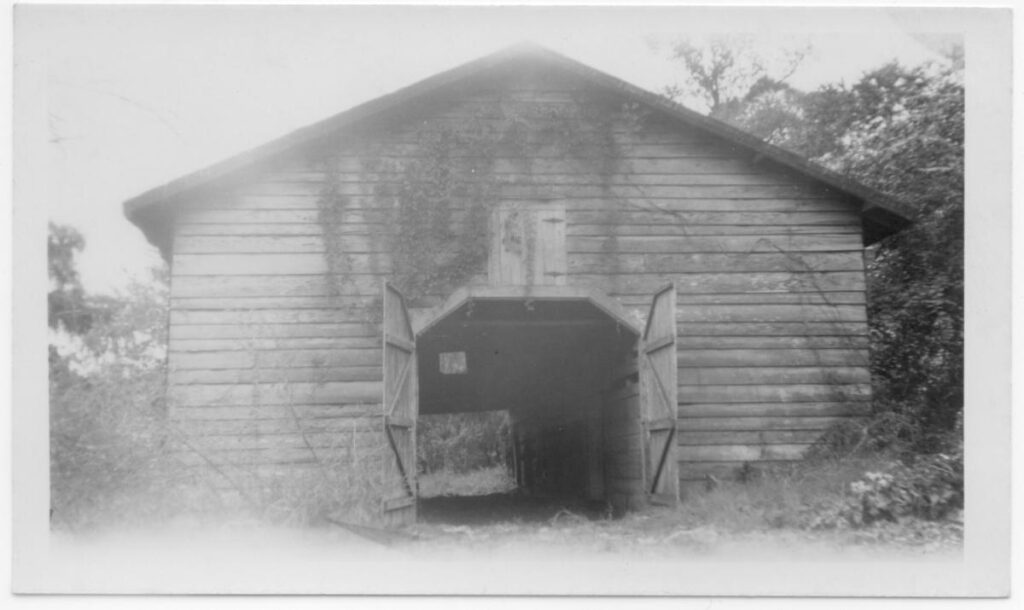
March 31, 2023
The Truman Moore Touch
If you stay on the main paths of Meher Spiritual Center, you will never find yourself far from a building that was built by Truman Moore and Moore Construction.
Truman Ellinwood Moore, a native of Shelby, NC, was born in 1901. He left his southern roots to attend the Chicago Institute of Art and graduated in 1923. In the 1940s, he joined his brother Jeff in Myrtle Beach in the construction business, and in 1946, they founded the first general contracting company in the area. By 1971, Moore Construction employed thirty people. A Myrtle Beach resident remarked: “Don’t anybody ever think that Truman Moore ever stopped being a professional artist. Every house he ever built, every one he ever touched is in its way a work of art.” [I]
The first cabin built on Meher Center was built by Truman Moore. Cabin on the Hill, located atop a gentle knoll with a view of Long Lake, was initially built for Meher Baba’s use. With a budget of $1000 and post-war restrictions on lumber, Truman Moore was able to build a two-room cabin with a bath, fireplace, and a large screened porch. The larger room was for Baba, and the smaller room was for one of His mandali to be nearby. The windows were intentionally placed high to afford Meher Baba privacy. There was still a bit of money left, and the funds went towards the quaint little kitchen that would become known as The Original Kitchen.
Knowing that Meher Baba would require a structure to meet with His lovers and to hold public meetings, Elizabeth Patterson and Norina Matchabelli, undaunted by the post-wartime building restrictions, put their heads together and came up with a solution. They purchased a mule barn made of cypress that was for sale in the nearby town of Conway. The barn was dismantled, board by board, and like building blocks, it was transported in sections to the Center. Elizabeth then asked Truman to reimagine the barn without stalls and supporting posts; Truman didn’t see how that was possible. Elizabeth was persistent, and he eventually came up with the wooden truss framework that Norina had painted Mediterranean blue. No one’s view of Meher Baba would ever be blocked. A fireplace was added and Truman carved the beautiful mantlepiece.
Later, Meher Baba told Elizabeth that He would like a more secluded and private house surrounded by a fence. Truman used the blueprints that she had discovered for “the perfect house”—a brick bungalow—and constructed the outstanding home. The interior wall between Baba’s bedroom and the living room is a double-thick wall. The windows in Baba’s bedroom are extra thick, with thicker sashes and glass. During Meher Baba’s 1956 visit to the Center, He said, “Of all the places in the world, I feel most comfortable in this house; even though the climate is hot and humid, I like this place.” [II]
Moore Construction built the Original Kitchen patio porch enclosure as well as the Lakeview Kitchen structure, Dilruba, the Saroja Library, Meher House, the original Refectory, the original Meeting Place, the first Gateway (now Archives), and the Bungalow. Moore Construction was also involved in the moving and establishment of the buildings donated to the Center in 1973, which included Happy House, the Cove, and the Tree Room.
Truman was a deacon of the Ocean View Baptist Church, a member of the board of directors of the Chapin Foundation (a philanthropic organization founded by Elizabeth’s father, Simeon Chapin), and the contractor for many of the buildings in Myrtle Beach, the list of which includes: The Chapin Library, the First Presbyterian Church, Ocean View Memorial Hospital, and the Myrtle Beach High School.
Lee McBride, Maintenance and Grounds Supervisor, was employed by Moore Construction in 1972 prior to coming to work at Meher Center. He told me that Truman Moore “had an aura of self contained calmness about him. Coworkers said he never raised his voice in the context of the construction work.”
Sometime after relocating to Myrtle Beach, Truman started wood sculpting. He is best known for his bas-relief sculptures, many of which feature a sacred theme. He integrated carving into his building projects using mostly local woods and created banisters, mantles, and lovely residential doors, one of which is the main door to Meher House.
Truman was also the master recycler when it came to wood. He salvaged old lumber from factories and warehouses that were being torn down. He recovered pieces left from the Myrtle Beach Second Avenue Pier after it was destroyed by Hurricane Hazel. He reinvented reclaimed wood.
Later in life, Truman was awarded a plaque from the American Institute of Architects for his contributions in the field of wood. He was dedicated to his craft and offered wood carving lessons to the locals. Several young Baba devotees enrolled in his class.
The Center is infused with Truman Moore’s touch, and the structures he built are lovingly cared for in accordance with Meher Baba’s instructions given to Elizabeth to keep the Center in perfect working order.
[I] “And After 30 years,” by Francis Moore, Sun News, June 7, 1970II] Love Alone Prevails, by Kitty Davy, p.466